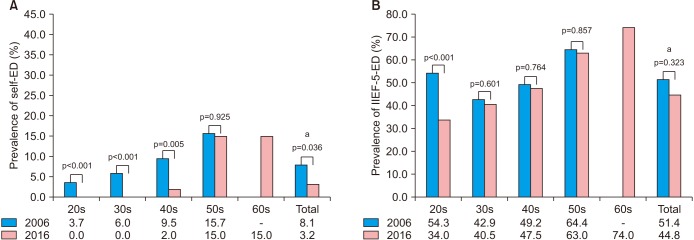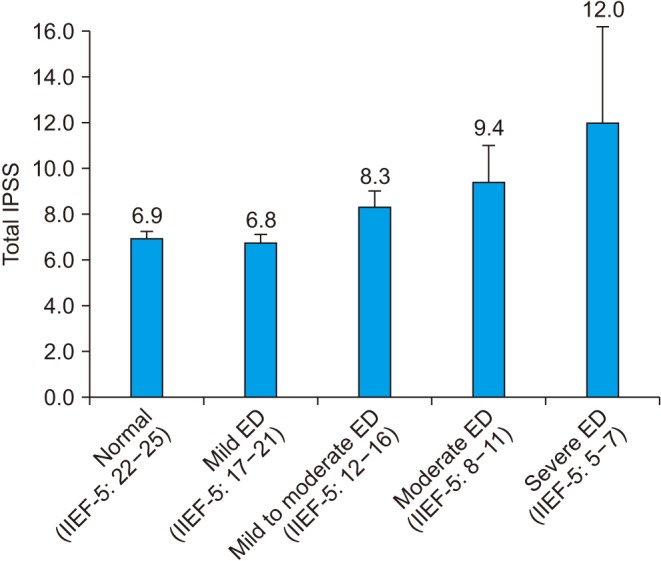Changes in the Prevalence and Risk Factors of Erectile Dysfunction during a Decade: The Korean Internet Sexuality Survey (KISS), a 10-Year-Interval Web-Based Survey
- Affiliations
-
- 1Department of Urology, Seoul National University College of Medicine, Seoul, Korea. volley@snu.ac.kr
- 2Department of Urology, SMG-SNU Boramae Medical Center, Seoul, Korea.
- 3Department of Biostatistics, SMG-SNU Boramae Medical Center, Seoul, Korea.
- KMID: 2443235
- DOI: http://doi.org/10.5534/wjmh.180054
Abstract
- PURPOSE
Although the prevalence of erectile dysfunction (ED) can be affected by social changes, this association has not been well evaluated. We aimed to evaluate the prevalence and risk factors of ED through a 10-year-interval web-based survey using the previous database of same group of panels, with same methodology.
MATERIALS AND METHODS
We sent e-mails and surveyed the panels registered in the Internet survey agency.
RESULTS
In total, 900 participants were recruited in 2016. The age-adjusted overall prevalences of self-reported ED (self-ED) and International Index of Erectile Function-5-assessed ED (IIEF-5-ED; score ≤21) in the 2016 study were 3.2% and 44.8%, respectively, which were lower than the prevalences of 8.1% (p=0.036) and 51.4% (p=0.323), respectively, in the 2006 study. The risk factors of IIEF-5-ED in their 20s and 30s in 2016 were psycho-social factors such as depression, low frequency of conversation about sex with sexual partner. The risk factors of IIEF-5-ED in their 40s to 60s in 2016 were organic factors, such as hypertension, diabetes mellitus, smoking, alcohol use, and self-reported premature ejaculation.
CONCLUSIONS
Although the age-adjusted overall prevalence of self-ED has decreased during a decade, there was no difference in the age-adjusted overall prevalence of IIEF-5-ED. Psycho-social support may be important for young men with ED and overall healthcare can be helpful for elderly men with ED.
Keyword
MeSH Terms
Figure
Cited by 2 articles
-
Synergistic effects of extracorporeal shockwave therapy and modified Ojayeonjonghwan on erectile dysfunction in an animal model of diabetes
Hyun Cheol Jeong, Woong Jin Bae, Guan Qun Zhu, Seung Hwan Jeon, Sae Woong Choi, Su Jin Kim, Hyuk Jin Cho, Sung-Hoo Hong, Ji Youl Lee, Sung Yeoun Hwang, Sae Woong Kim
Investig Clin Urol. 2019;60(4):285-294. doi: 10.4111/icu.2019.60.4.285.Treatment persistence with a fixed-dose combination of tadalafil (5 mg) and tamsulosin (0.4 mg) and reasons for early discontinuation in patients with benign prostatic hyperplasia and erectile dysfunction
Sun Tae Ahn, Dong Hyun Lee, Hyeong Guk Jeong, Jong Wook Kim, Mi Mi Oh, Hong Seok Park, Du Geon Moon
Investig Clin Urol. 2020;61(1):81-87. doi: 10.4111/icu.2020.61.1.81.
Reference
-
1. Choi WS, Song SH, Son H. Epidemiological study of complementary and alternative medicine (CAM) use for the improvement of sexual function in young Korean men: the Korean Internet Sexuality Survey (KISS), part II. J Sex Med. 2012; 9:2238–2247. PMID: 22616848.
Article2. Cho SY, Son H, Kim SW, Paick JS. Should men with mild erectile dysfunction be closely evaluated for cardiovascular diseases in the Korean population? Aging Male. 2014; 17:81–86. PMID: 24397687.
Article3. Laumann EO, Paik A, Rosen RC. Sexual dysfunction in the United States: prevalence and predictors. JAMA. 1999; 281:537–544. PMID: 10022110.4. Feldman HA, Goldstein I, Hatzichristou DG, Krane RJ, McKinlay JB. Impotence and its medical and psychosocial correlates: results of the Massachusetts Male Aging Study. J Urol. 1994; 151:54–61. PMID: 8254833.
Article5. Braun M, Wassmer G, Klotz T, Reifenrath B, Mathers M, Engelmann U. Epidemiology of erectile dysfunction: results of the ‘Cologne Male Survey’. Int J Impot Res. 2000; 12:305–311. PMID: 11416833.
Article6. Tan HM, Low WY, Ng CJ, Chen KK, Sugita M, Ishii N, et al. Prevalence and correlates of erectile dysfunction (ED) and treatment seeking for ED in Asian Men: the Asian Men’s Attitudes to Life Events and Sexuality (MALES) study. J Sex Med. 2007; 4:1582–1592. PMID: 17908233.
Article7. Kim M, Shin GH, Ryoo S, Ko S, Kim H, Song SH, et al. The prevalence and risk factors for erectile dysfunction in Korean young men: a web-based survey. Korean J Androl. 2006; 24:76–83.8. Shaeer O, Shaeer K. The Global Online Sexuality Survey (GOSS): the United States of America in 2011. Chapter I: erectile dysfunction among English-speakers. J Sex Med. 2012; 9:3018–3027. PMID: 23088651.
Article9. Esposito K, Giugliano F, Di Palo C, Giugliano G, Marfella R, D'Andrea F, et al. Effect of lifestyle changes on erectile dysfunction in obese men: a randomized controlled trial. JAMA. 2004; 291:2978–2984. PMID: 15213209.10. Shabsigh R, Broderick GA, Althof S, Natanegara F, Wong DG. Daily patterns of sexual intercourse attempts by men with erectile dysfunction treated with tadalafil: influence of age and marital status. Int J Impot Res. 2009; 21:285–291. PMID: 19536126.
Article11. Son H, Song SH, Kim SW, Paick JS. Self-reported premature ejaculation prevalence and characteristics in Korean young males: community-based data from an internet survey. J Androl. 2010; 31:540–546. PMID: 20671139.
Article12. Son H, Song SH, Lee JY, Paick JS. Relationship between premature ejaculation and depression in Korean males. J Sex Med. 2011; 8:2062–2070. PMID: 21235722.
Article13. Choo V. WHO reassesses appropriate body-mass index for Asian populations. Lancet. 2002; 360:235.
Article14. Giuliano F, Chevret-Measson M, Tsatsaris A, Reitz C, Murino M, Thonneau P. Prevalence of erectile dysfunction in France: results of an epidemiological survey of a representative sample of 1004 men. Eur Urol. 2002; 42:382–389. PMID: 12361905.
Article15. Malavige LS, Jayaratne SD, Kathriarachchi ST, Sivayogan S, Fernando DJ, Levy JC. Erectile dysfunction among men with diabetes is strongly associated with premature ejaculation and reduced libido. J Sex Med. 2008; 5:2125–2134. PMID: 18624974.
Article16. Nicolosi A, Moreira ED Jr, Shirai M, Bin Mohd, Glasser DB. Epidemiology of erectile dysfunction in four countries: cross-national study of the prevalence and correlates of erectile dysfunction. Urology. 2003; 61:201–206. PMID: 12559296.
Article17. Laumann EO, West S, Glasser D, Carson C, Rosen R, Kang JH. Prevalence and correlates of erectile dysfunction by race and ethnicity among men aged 40 or older in the United States: from the male attitudes regarding sexual health survey. J Sex Med. 2007; 4:57–65. PMID: 17081223.
Article18. Ahn TY, Park JK, Lee SW, Hong JH, Park NC, Kim JJ, et al. Prevalence and risk factors for erectile dysfunction in Korean men: results of an epidemiological study. J Sex Med. 2007; 4:1269–1276. PMID: 17635695.
Article19. Al Naimi A, Majzoub AA, Talib RA, Canguven O, Al Ansari A. Erectile dysfunction in qatar: prevalence and risk factors in 1,052 participants-a pilot study. Sex Med. 2014; 2:91–95. PMID: 25356303.
Article20. NIH Consensus Conference. Impotence. NIH consensus development panel on impotence. JAMA. 1993; 270:83–90. PMID: 8510302.22. Nguyen HMT, Gabrielson AT, Hellstrom WJG. Erectile dysfunction in young men: a review of the prevalence and risk factors. Sex Med Rev. 2017; 5:508–520. PMID: 28642047.23. McVary KT, Carrier S, Wessells H. Subcommittee on Smoking and Erectile Dysfunction Socioeconomic Committee, Sexual Medicine Society of North America. Smoking and erectile dysfunction: evidence based analysis. J Urol. 2001; 166:1624–1632. PMID: 11586190.
Article24. Lee SW, Lee JH, Sung HH, Park HJ, Park JK, Choi SK, et al. The prevalence of premature ejaculation and its clinical characteristics in Korean men according to different definitions. Int J Impot Res. 2013; 25:12–17. PMID: 22931761.
Article25. McMahon CG, Lee G, Park JK, Adaikan PG. Premature ejaculation and erectile dysfunction prevalence and attitudes in the Asia-Pacific region. J Sex Med. 2012; 9:454–465. PMID: 22023395.
Article26. Rosen R, Altwein J, Boyle P, Kirby RS, Lukacs B, Meuleman E, et al. Lower urinary tract symptoms and male sexual dysfunction: the multinational survey of the aging male (MSAM-7). Eur Urol. 2003; 44:637–649. PMID: 14644114.
Article27. Kim SW, Park NC, Lee SW, Yang DY, Park JK, Moon DG, et al. Efficacy and safety of a fixed-dose combination therapy of tamsulosin and tadalafil for patients with lower urinary tract symptoms and erectile dysfunction: results of a randomized, double-blinded, active-controlled trial. J Sex Med. 2017; 14:1018–1027. PMID: 28760246.
Article28. Egan KB, Burnett AL, McVary KT, Ni X, Suh M, Wong DG, et al. The co-occurring syndrome-coexisting erectile dysfunction and benign prostatic hyperplasia and their clinical correlates in aging men: results from the National Health and Nutrition Examination Survey. Urology. 2015; 86:570–580. PMID: 26210004.
Article29. Manana PN, Kuonza L, Musekiwa A, Koornhof H, Nanoo A, Ismail N. Feasibility of using postal and web-based surveys to estimate the prevalence of tuberculosis among health care workers in South Africa. PLoS One. 2018; 13:e0197022. PMID: 29746507.
Article30. Couper MP. Web surveys: a review of issues and approaches. Public Opin Q. 2000; 64:464–494. PMID: 11171027.
- Full Text Links
- Actions
-
Cited
- CITED
-
- Close
- Share
- Similar articles
-
- Application of Evaluation Criteria for Web sites to Sexuality Education
- The Prevalence and Risk Factors for Erectile Dysfunction in Korean Young Men: a Web-based Survey
- Epidemiologic Study of the Male Erectile Dysfunction with Risk Factors in Rural Area
- Prevalence of Sexual Dysfunction in Men Older Than 40 Living in Seoul: Epidemiologic Survey Using Questionnaire
- Utilization of Internet-based Medical Information Services and Hospital Selection among Health Care Consumers: Internet Survey



